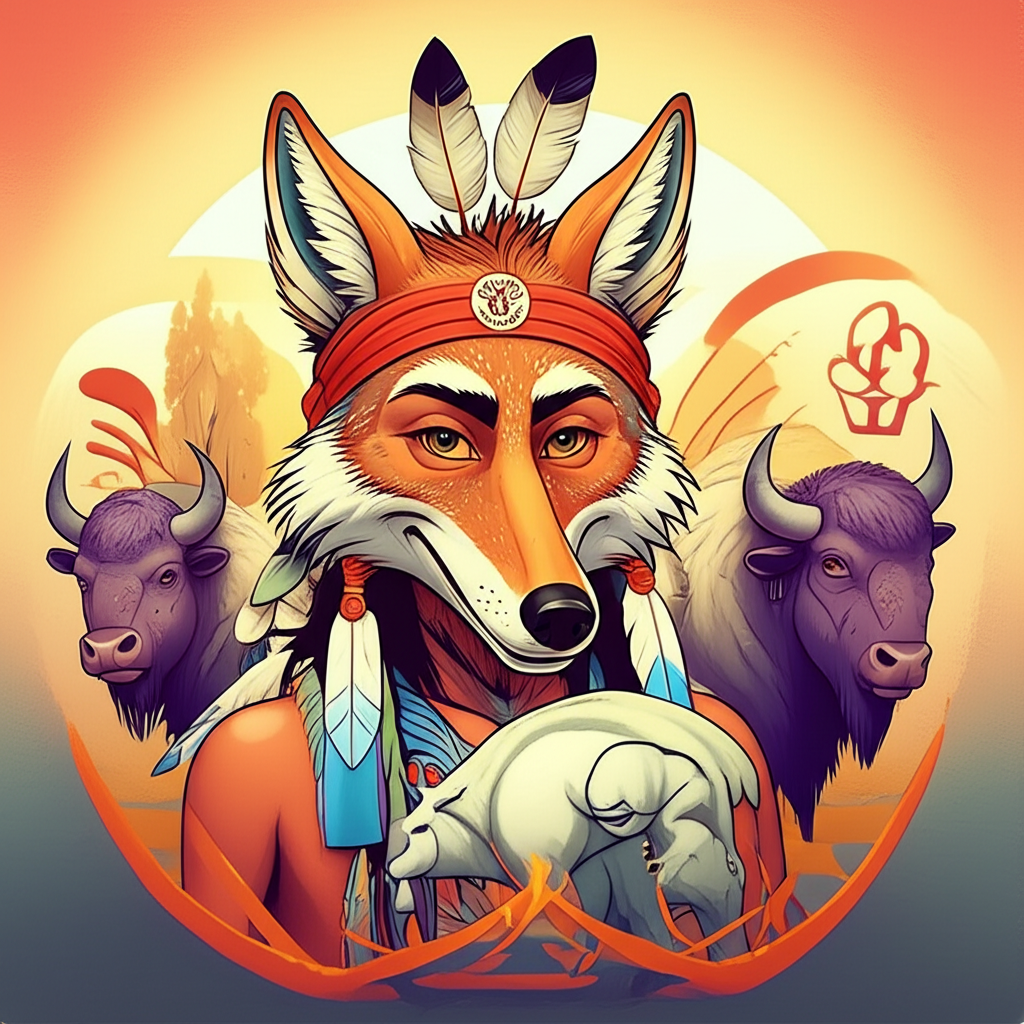
Across the vast, wind-scoured plains of North America, where the sky stretched endlessly and the earth hummed with ancient rhythms, stories were the lifeblood of communities. These were not mere tales spun for amusement, but intricate tapestries woven from observation, experience, and a profound understanding of the natural world. Among the many narratives passed down through generations by Indigenous peoples, particularly those of the Plains tribes, are those featuring Coyote, a figure as ubiquitous as the prairie wind itself, and the potent symbolism of the White Buffalo. This is the story of a legend, a traditional narrative that speaks of balance, transformation, and the deep connection between humanity and the spirit of the land. It is important to remember that this is a cultural story, a testament to the rich imaginative heritage of ancient peoples, and not a matter of current belief or practice.
The origins of such stories are deeply rooted in the pre-colonial era, a time when life on the Great Plains was dictated by the migrations of the buffalo herds and the cycles of the seasons. Societies were largely nomadic, following the bounty of the land, and their worldview was one of intricate interdependence. The natural world was not seen as separate from humanity, but as a living, breathing entity, imbued with spirit and wisdom. Every element, from the soaring hawk to the burrowing prairie dog, held significance. The sky was the domain of the Great Spirit, the earth the mother that nourished all, and the animals were often viewed as kin, possessing their own forms of intelligence and spiritual power. In this context, myths and legends served as vital tools for understanding the universe, teaching moral lessons, and preserving cultural identity.
Central to this particular narrative is Coyote, a creature revered and feared in equal measure. Coyote is not a god, nor a devil, but a primal force, a shapeshifter, a trickster. He embodies duality: he can be foolish and cunning, benevolent and mischievous, wise and utterly chaotic. His fur is the color of dust and twilight, his eyes gleam with an intelligence that seems to understand secrets no human can fathom. Coyote is the embodiment of adaptability, of survival, and of the wild, untamed spirit that exists beyond the boundaries of human order. He is the one who can disrupt the mundane, who can challenge authority, and who often, through his often-unintended consequences, brings about profound change. He represents the unpredictable nature of life, the moments when the carefully constructed order of the world is overturned by forces beyond comprehension.
The White Buffalo, on the other hand, is a creature of immense spiritual significance. While exceedingly rare, a white buffalo calf was a sacred omen, a sign of hope, abundance, and spiritual renewal. Its appearance was considered a divine blessing, a promise that the world was still in balance and that the Great Spirit was watching over its people. The white color symbolized purity, the dawn of a new era, and a connection to the sacred.
In the traditional stories, the land was not always in harmony. There were times when imbalance threatened to overwhelm the delicate equilibrium of existence. These were periods of hardship, of scarcity, and of spiritual malaise. It is in such a time that the legend of the White Buffalo Prophecy and Coyote’s role within it would often be recounted.
The narrative unfolds like this: The land was parched, the buffalo herds had dwindled, and despair was settling like a shroud over the people. The spirits of the animals seemed distant, their songs muted. The elders, their faces etched with worry, consulted the ancient signs, but found little solace. It was said that a prophecy foretold a time of great darkness, a time when the very essence of life would be tested. But within that prophecy lay a glimmer of hope: the birth of a White Buffalo calf, a sign that could herald a return to balance.
Enter Coyote. Ever present, ever observing, he moved through the desolate landscape, his keen senses picking up the faintest whispers of distress. He saw the hunger in the eyes of the people and the weariness in the bones of the land. While he did not possess the solemn reverence of the elders for the sacred, he understood the interconnectedness of all things. He, in his own peculiar way, felt the imbalance.
Driven by a mixture of curiosity and perhaps a flicker of something akin to empathy, Coyote embarked on a quest. He did not set out with a noble decree or a divine mission. Instead, he followed the scent of something unusual, a subtle shift in the air, a feeling that something extraordinary was about to occur. He traversed the plains, his shadow a fleeting streak against the setting sun, his sharp ears attuned to the rustling of dry grass and the distant cries of unseen creatures.
Through his trickster nature, his ability to adapt and to navigate the fringes of the known, Coyote stumbled upon the sacred event. Perhaps he was drawn by the unusual stillness that accompanied the birth, or by a scent unlike any other he had encountered. He witnessed the arrival of the White Buffalo calf, a being of such ethereal beauty that even Coyote, the jaded observer of all things, was struck into a rare moment of quiet awe.
The prophecy, as told, was not about Coyote bringing the White Buffalo. Rather, it was about Coyote’s witnessing and, through his unique perspective, his potential to interpret or carry the message of its arrival. He was the wild, the untamed, the one who existed outside the rigid structures of human society, and therefore, perhaps, he was the one best positioned to recognize a fundamental shift in the spirit of the land.
Coyote’s role was not to perform a grand ritual. It was to observe, to understand, and then, in his own inimitable fashion, to spread the word. He would yip and howl, his voice echoing across the plains, carrying the news of the sacred birth. His calls were not a formal announcement, but a wild, joyous cacophony that would alert the people. He would lead them, perhaps not directly, but through his movements, his presence, drawing their attention to where the signs of renewal were manifesting. He was the messenger, the unpredictable herald of hope.
The birth of the White Buffalo calf, interpreted through the lens of Coyote’s actions, was seen as a turning point. It signified that the balance could be restored, that the Great Spirit had not abandoned the people. The presence of the calf, and the subsequent understanding of its significance, would inspire renewed hope, a renewed commitment to living in harmony with the natural world. The people, guided by the wisdom of their elders and the subtle nudges of the wild, would begin to heal their relationship with the earth, and the buffalo herds, in time, would flourish once more.
The symbolism within this myth is multifaceted. Coyote represents the wildness that is inherent in nature, the unpredictable element that can both disrupt and ultimately facilitate change. He embodies the primal instincts, the survival mechanisms, and the often-unforeseen consequences of actions. The White Buffalo, conversely, is a symbol of purity, of hope, and of spiritual renewal. Its rarity underscores the preciousness of balance and the profound impact of divine favor. The prophecy itself speaks to the cyclical nature of life, the inevitable periods of hardship followed by times of resurgence. It speaks of the deep respect Indigenous peoples held for the interconnectedness of all living things, where the fate of humanity was inextricably linked to the health of the land and its creatures.
In the modern world, these ancient narratives continue to resonate. The figure of Coyote as a trickster archetype appears in countless contemporary stories, films, and literature, often serving as a catalyst for plot development or as a commentator on societal norms. The White Buffalo remains a powerful symbol of hope and spiritual significance, particularly within Indigenous communities and in broader discussions about conservation and the reverence for nature. Cultural studies scholars delve into these myths to understand the worldview, values, and spiritual beliefs of ancient peoples. In video games and art, these figures are often reimagined, showcasing their enduring power to capture the imagination.
It is crucial to reiterate that these are traditional stories, rich with cultural meaning and artistic expression, originating from the traditions of ancient peoples. As Muslims, we recognize that only Allah (God) is the true Creator and Sustainer of all that exists. These narratives, while fascinating and insightful, are products of human imagination and cultural heritage, not divine revelation.
The story of Coyote and the White Buffalo Prophecy serves as a powerful reminder of the enduring strength of storytelling traditions. It highlights how ancient peoples sought to understand their world, to find meaning in its complexities, and to pass down wisdom through imaginative and evocative tales. These stories, born from the whispers of the prairie and the wisdom of the land, continue to offer us a glimpse into a worldview that prioritized balance, interconnectedness, and a profound respect for the natural world, a legacy that, even as cultural artifacts, continues to enrich our understanding of human history and the boundless capacity of the human spirit for storytelling.





